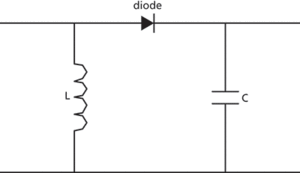A simple way of detecting the presence of a radiofrequency (RF) signal, and extracting any amplitude-modulated signal present. The detection is by rectification of the RF voltage, and then a low-pass filter action extracts the baseband or DC signal that is proportional to the RF signal power (see diagram). This type of detector is known as a square-law detector. It is inherently wide bandwidth.
The detection process can be analysed by considering the nonlinear current-voltage relationship of a p-n junction diode or metal-semiconductor (Schottky) diode. The diode is biased at some voltage VDC; the RF signal that is applied to the detector will be smaller in amplitude:
where A is the RF signal amplitude, which may be modulated, and ω is the RF frequency. The total voltage across the diode junction is then
The diode current can then be found using a Taylor series expansion for the I–V relation, around the bias point. This gives
where α = e/kT. The first term on the righthand side is the DC bias current, the second term is the rectified or detected RF signal δI, and the remaining terms are high-frequency RF signals that are filtered out. The detected signal is thus proportional to the square of the RF signal amplitude: hence ‘square-law detector’. If the RF signal is amplitude modulated, then the output voltage from the detector will contain this baseband modulation, the RF signals being filtered by the action of the LC low-pass filter. In addition it can be shown that the detected current is also a measure of the RF power, Pj, dissipated in the junction:
The above analysis includes a DC bias current and is therefore quite general. In many applications the detector diode is unbiased: VDC = IDC = 0. While this does not affect the general result above, it should be noted that the junction resistance Rj is a bias-dependent parameter, and thus the RF power detected will be a function of Rj and hence bias voltage, which can be used to adjust the sensitivity of the detector.

Simple diode detector circuit
- back breeding
- back cross
- back donation
- back door
- backdoor
- back driving
- back electromotive force
- back e.m.f.
- back end
- back end database
- back end process
- back-end processor
- back end system
- back-face detection
- backflushing
- backgating
- background noise
- background processing
- background radiation
- background variable
- back heating
- backing
- backing store
- backing up
- backlash